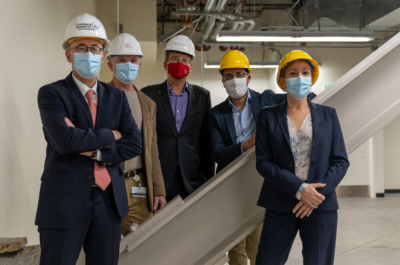Multidisciplinary team will study, develop, manufacture and test cell-based treatments for a wide range of diseases and disorders.

By Landon Hall
The essence of translational medicine is taking an idea from the drawing board and “translating” it into a real-world treatment that helps patients. The winding road of that process takes plenty of time, money and expertise, so it makes sense to place it all under one roof.
USC and Children’s Hospital Los Angeles (CHLA) are doing just that: Through a partnership among CHLA, the Keck School of Medicine of USC, Keck Medicine of USC, and the USC Norris Comprehensive Cancer Center, construction has begun on a facility located on the USC Health Sciences Campus, where a multidisciplinary team of scientists will be studying, developing, manufacturing and testing cell-based treatments for a wide range of diseases and disorders. The new facility is part of a larger program, the USC/CHLA Cell Therapy Program, which will advance the science and translation of cell therapies at both institutions.
“Our vision is to advance cell therapy research at USC and CHLA so they can be leading centers and a hub for this type of research,” said Mohamed Abou-el-Enein, MD, PhD, MSPH, Executive Director of the USC/CHLA Cell Therapy Program. The new facility, a key component of the joint program, is scheduled to be completed in 2022, and Abou-el-Enein will serve as its Director.
“Having it established here will be a great enabler for all the scientific concepts being developed to really move forward into the clinic and treat hundreds of patients with incurable diseases,” he added.
Details on the high-tech facility
The planned 3,184-square-foot facility is being constructed in the basement of the Harlyne Norris Research Tower at the USC Norris Comprehensive Cancer Center. It’s called a cGMP, which stands for Current Good Manufacturing Practice facility. The designation was created by the Food and Drug Administration to regulate the production of pharmaceuticals and other treatments, such as cell therapies, under controlled conditions so they would be safe and efficacious. The USC/CHLA cGMP facility will feature six individual “clean rooms” on a dedicated manufacturing floor to produce multiple products without the potential of cross-contamination.

The underground facility will include six “clean” rooms. From left: Alan S. Wayne; Tom Buchanan; Nikos Carli; Mohamed Abou-el-Enein; and Caryn Lerman. (Photo/Sergio Bianco)
The products to be made at the cGMP facility will be mainly cell therapeutics, which can be thought of as “living drugs” because they are living cells modified to treat disease. The goal is to tailor cells and tissues to treat individual patients based on their condition/medical needs.
“Cell therapies harness the sophisticated biology of cells, which have evolved over millions of years, to create treatments that can be precisely targeted to specific diseases and tailored to each individual patient,” said Tom Buchanan, MD, Professor of Medicine and Vice Dean for Research at the Keck School of Medicine. “Cells are taken from the patient, modified in the cGMP facility, and returned to the patient. In some cases, they are designed to kill harmful cells, for example cancer cells. In other cases, they can replace missing cells like cartilage in people with arthritis. It is all done with great precision that only cells can provide. This is truly precision medicine.”
Cell therapy has many applications
Cell therapies have potential application to many specialties of medicine, including cancer, ophthalmology, orthopedics, neurology and pediatrics, among many others.
“This new facility will allow us to develop and deliver new therapies to cure and treat children and adults with a wide variety of life-threatening diseases and conditions,” said Alan S. Wayne, MD, Director of the Cancer and Blood Disease Institute at CHLA. “We are extremely excited about the future, as these new cell therapies will allow us to treat diseases in completely new ways, bringing hope for the children we treat at Children’s Hospital Los Angeles and around the globe.”
“We are thrilled to have this new facility,” added Caryn Lerman, PhD, Director of the USC Norris Comprehensive Cancer Center. “It is going to transform cancer research at USC Norris, enabling us to develop the next cures for patients with cancer. It will also help us to bring this therapeutic revolution to patients across Los Angeles County and beyond.”
Nikos Carli, Associate Administrator of Strategy and Cancer Services at Keck Medicine, said: “This new state-of-the-art facility furthers the impact of our clinicians and researchers in fulfilling USC Norris’s goal of making cancer a disease of the past. It’s very exciting to think scientific breakthroughs originating here will benefit the care of cancer patients across the globe.”
The USC Norris Comprehensive Cancer Center provided the space for the facility and contributed to the hiring of Abou-el-Enein, who focuses on translational development of cell therapies for clinical trials. Rongfu Wang, PhD, Director of Cell Therapy Research in the Division of Hematology-Oncology at CHLA, and Professor of Pediatrics and Medicine at USC, will lead the pre-clinical development of cell therapies, with an emphasis on cancer.
The facility and overarching cell therapy program have been in development since 2018, when the first meeting among stakeholders was held. Its planning, execution and funding have been a collaborative effort across departments, disciplines and institutions.
“Our model is to create strong and meaningful partnerships with different researchers and scientists,” said Abou-el-Enein, who is a physician by training but has worked to master the intricacies of cell manufacturing for clinical research. “Of course, it takes more time, energy and manpower, but it ensures the success of translation, because usually scientists will be doing what they know best, and for them, translation is a huge task. And it is indeed huge.”